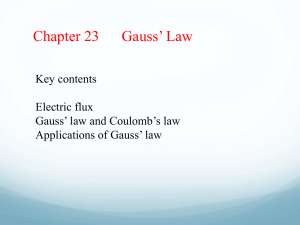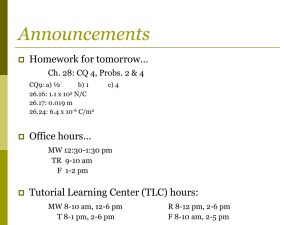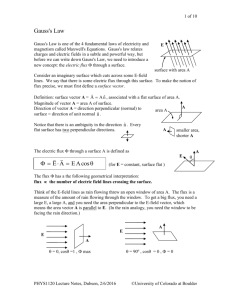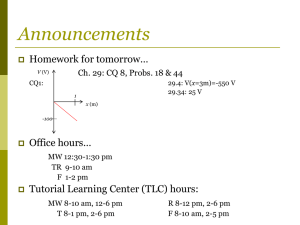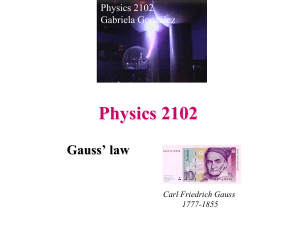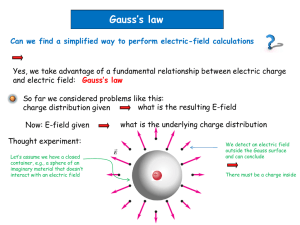PH504lec0809-5
advertisement
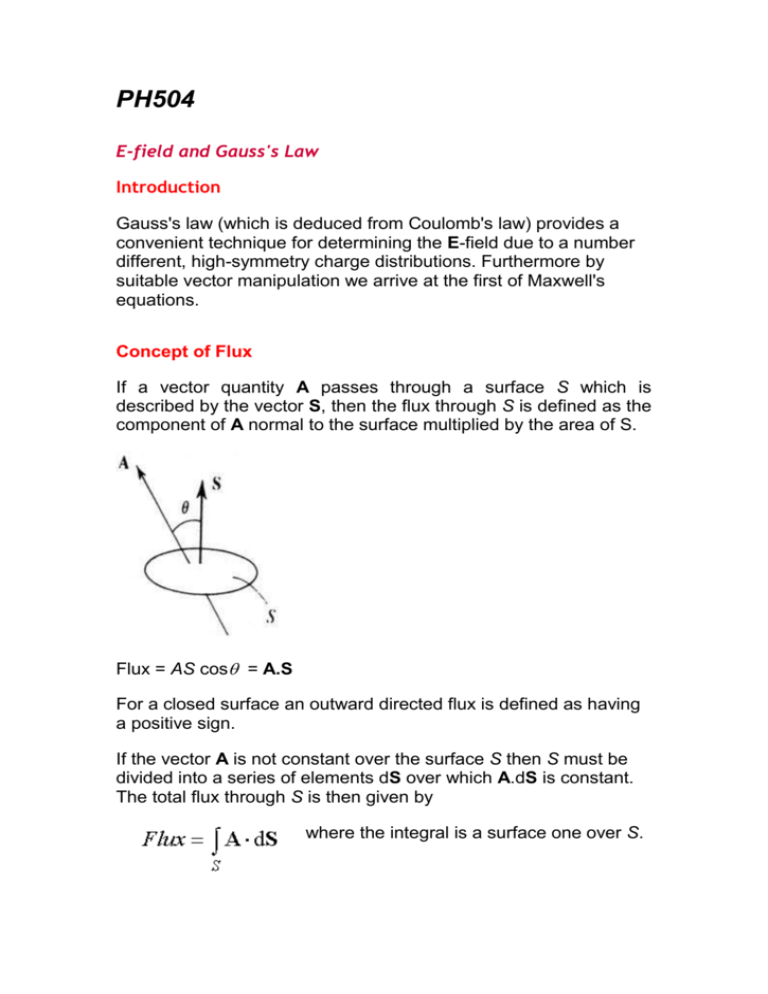
PH504 E-field and Gauss's Law Introduction Gauss's law (which is deduced from Coulomb's law) provides a convenient technique for determining the E-field due to a number different, high-symmetry charge distributions. Furthermore by suitable vector manipulation we arrive at the first of Maxwell's equations. Concept of Flux If a vector quantity A passes through a surface S which is described by the vector S, then the flux through S is defined as the component of A normal to the surface multiplied by the area of S. Flux = AS cos = A.S For a closed surface an outward directed flux is defined as having a positive sign. If the vector A is not constant over the surface S then S must be divided into a series of elements dS over which A.dS is constant. The total flux through S is then given by where the integral is a surface one over S. Gauss's Law Consider a point charge q enclosed by a surface S. Consider a general surface element dS which lies a distance r from q. The E-field at dS is and the flux through dS is hence given by….. Outward flux across dS However the term (dS cos)/r2 is simply the solid angle d subtended by dS at q (see maths notes for this course). Hence Outward flux across dS And total flux across closed surface S is The circle on the integral sign indicates that the integral is to be taken over a closed surface. From the principle of superposition any number of charges contained within S produce an individual flux through the surface which add together to give a total flux. Any charges lying outside of S contribute equal amounts of inward and outward flux and hence do not contribute to the total flux through S. Hence our final result which applies to a collection of charges Q within S, is (A) where the RHS represents the algebraic sum of all charges enclosed by the surface S divided by 0. Equation (A) gives the integral form of Gauss's law for E-fields. In words it states: 'the outward flux of E over any closed surface is equal to the algebraic sum of the charges enclosed by the surface divided by 0.' Some consequences of Gauss's applied to conductors A conductor contains at least some charges which are free to move within it. When initially placed in an external E-field the field will penetrate into the conductor and cause the free charges to move (Diagram a). However these can only move as far as the surface of the conductor (assuming it is of finite size). This maximizes the separation between the charges and minimizes the forces acting on them. Charge collects at the surface and produces an E-field within the conductor which opposes the external field. Equilibrium is quickly reached where the displaced charges produce an internal field which exactly cancels the external one (and hence there is no further movement of charge (Diagram b). within a conductor at equilibrium there can be no E-field. all points of the conductor must be at the same potential. The cancellation of the external electric field inside the conductor is used to shield sensitive instruments from external electric fields. Solid conductor in (a) carries a net charge. Within conductor E=0 hence flux through Gaussian surface G is zero and hence net charge contained within G is also zero. A solid conductor carries all its excess charge on the surface. Hollow conductor in (b) must also carry any excess charge on its outer surface. In (c) the hollow region contains a charge (+Q). In which case the inner surface must carry an equal but opposite charge -Q. These requirements are necessary to give a zero flux through the Gaussian surface G. It can also be shown that in case (b) E=0 within the hollow region. The electric field must be perpendicular to the surface. Why? Because the surface is an equipotential: Use of Gauss's Law to find the E-field due to symmetrical charge distributions (a) spherical but non-point charge. A conducting sphere of radius a carries a charge Q on its surface. By symmetry the resultant E-field must by spherically symmetric and hence can only have a radial component. Take as a Gaussian surface (G) a sphere of radius r (>a) placed concentric to the conductor. By symmetry the field E must be constant at all points on G and also normal to G. Flux through G = field x surface area = E.4r2 Total charge enclosed by surface is Q E.4r2=Q/0 Hence: E=Q/(40r2) V= Q/(40r) ………. zero at ….as if entire charge were concentrated at the centre. For r<a (within conductor) charge contained within G is zero (all charge is on surface) E = 0. Hence potential within sphere must be constant and equal to surface potential = Q/(40a). therefore: (b) infinite plane of charge. An infinite (or very large) sheet carries a uniform charge density . By symmetry the resultant E-field must have a direction normal to the plane and must have the same size at all points a common distance from the plane. Take as a Gaussian surface a cylinder of cross-sectional area A and height 2h. Flux is only non-zero through ends of cylinder. If field at cylinder ends is E then total flux is 2EA. Charge enclosed is area x charge density = A Hence from Gauss's law 2EA=A/0 E = / 20 Electric field is a constant!! This is much easier than the integration method. Semi-infinite thickness plane conductor (Diagram b).The electric field at the surface of the conductor is given by …exactly double the sheet result! Differential form of Gauss's Law : general argument The integral form is We now consider the general case where the charge contained within the surface S is continuously distributed with a volume density (which may be depend upon spatial position). In this case the total charge within S is given by a suitable volume integral of . where is the volume enclosed by the surface S. Hence Gauss's law is now We now apply Gauss's divergence theorem to convert the surface integral on the LHS to a volume integral. Gauss's theorem states that 'if a closed surface S encloses a volume then the surface integral of any vector A over S is equal to the volume integral of the divergence of A over .' Mathematically Gauss's theorem can be written as where A is the divergence of the vector A. Applying the divergence theorem to Gauss's law we have The two volume integrals can now be combined as they are both evaluated over the same volume As this is true for any closed surface the result requires that at every point in space This is Gauss's law for electric fields in differential form. It is the first of Maxwell's equations. In words Gauss’s law states that 'at any point in space the divergence of the E-field is equal to the charge density at that point divided by 0.' As the divergence can be thought of as giving the number of field lines starting (if positive) or terminating (if negative) at a given point, the above equation states that: ‘the number of field lines starting or terminating at a given point is proportional to the charge density at that point’. Poisson's and Laplace's equations We have Combining these equations we obtain where in Cartesian co-ordinates this is Poisson's equation. At points where the charge density is zero (=0) Poisson's equation reduces to Laplace's equation Poisson's and Laplace's equations are often used to find V for a given charge distribution and boundary conditions. In cylindrical and spherical coordinates: Seek ‘separable’ solutions of the form R(r)S(), gives spherical harmonic functions and Legendre polynomials: The circuital law for E-fields We have shown that the electric potential difference between two points A and B (VBA) is given by where the integral is a line one between points A and B. Now consider two different paths between points A and B (I and II). We know that VBA is independent of the path taken between A and B and hence If we now traverse path II in the opposite direction (from B to A) the resultant line integral has a value of -VBA. Hence we can write but the addition of the two integrals is now simply the line integral of E around a closed path (A to B by path I followed by B back to A by path II). Hence This result states that ‘the line integral of E around any closed path in an electrostatic field is zero. Alternatively the work done in taking a test charge round any closed path in an electrostatic field is zero’. This result is a consequence of the central nature of the E-field due to static charges. In this case the E-field is said to be conservative. The above result is only true for E-fields produced by static charges (electrostatics). We will see in subsequent lectures that in situations where we have a time varying magnetic field that Consequences of the E-field circuital law Because the circuital law has a null result it is not particularly useful for solving specific problems. However one useful deduction concerns the form of the E-field at the surface of a conductor. Consider the surface of a conductor and the rectangular path as shown. The two ends of the path can be made very small so that they don't contribute to the line integral. Within the conductor we know that E=0. Hence to satisfy the E-field along the top edge of the path must also be zero. Hence there is no tangential component of E just outside the surface of the conductor and hence any E-field must be entirely normal to the surface. 'The E-field just outside a charged conductor is always normal to its surface.' The differential form of the circuital law We have for electrostatics that Stoke's theorem states that ‘if a closed path L bounds a surface S, then the surface integral of the curl of a vector A over S is equal to the line integral of A around L.’ where xA is the curl of vector A. Applying Stoke’s theorem to the circuital law for E gives as we can make the area S infinitesimally small. Hence the curl of any electrostatic E-field is always zero. This is the differential form of the circuital law. This result also follows because E is given by the gradient of the electric potential and it can be shown that the curl of any vector which is derived from the gradient of a scalar function is always zero: V=0 Conclusions Concept of flux Derivation of Gauss's law in integral form Some consequences arising from Gauss’s law – E-fields in conductors. Use of Gauss’s law to determine the E-field resulting from symmetrical charge distributions Gauss's law in differential form Poisson's and Laplaces's equations The circuital law for electrostatic E-fields Integral form Differential form E=0

